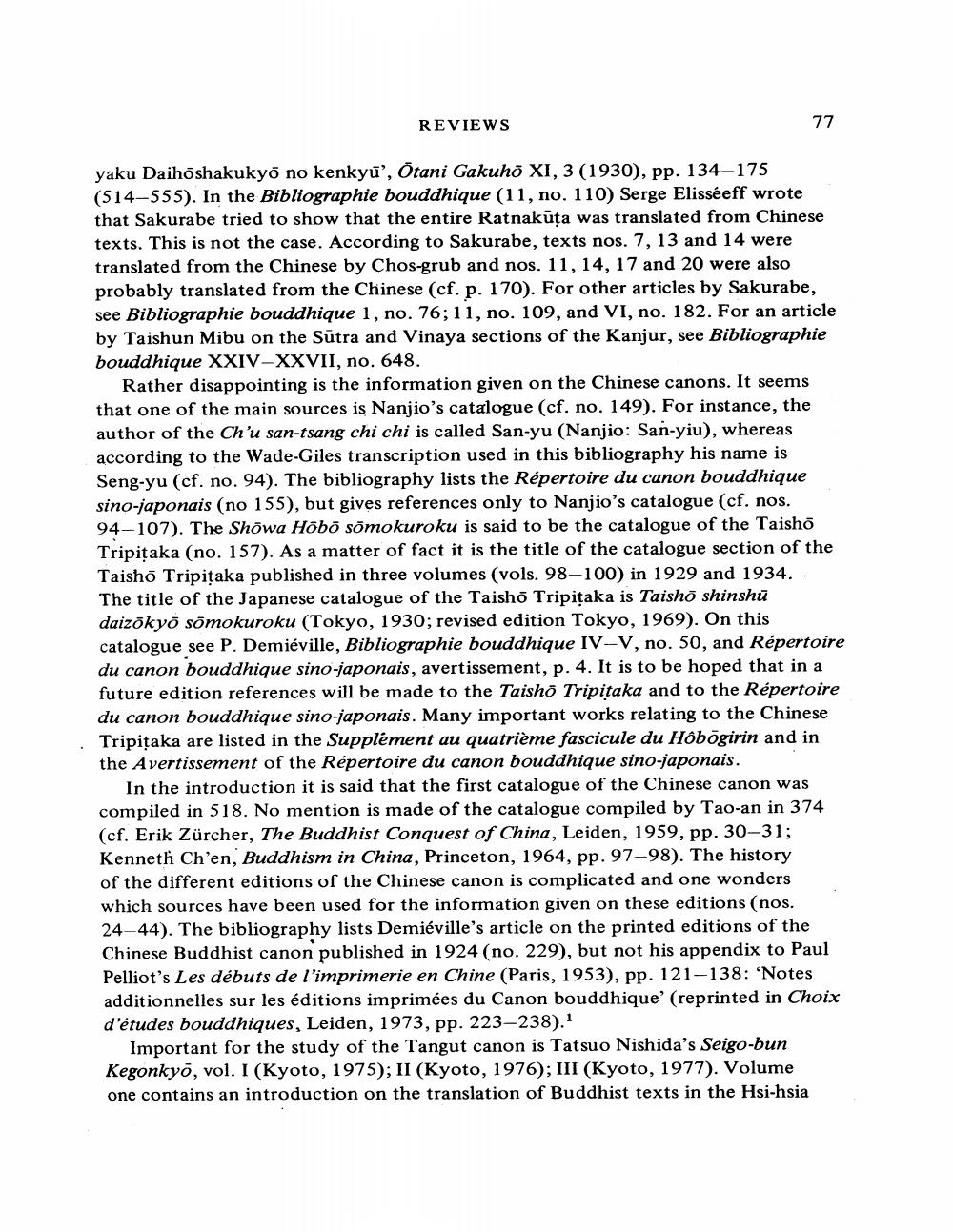________________
REVIEWS
77
yaku Daihōshakukyo no kenkyu', Otani Gakuho XI, 3 (1930), pp. 134-175 (514-555). In the Bibliographie bouddhique (11, no. 110) Serge Elisséeff wrote that Sakurabe tried to show that the entire Ratnakuta was translated from Chinese texts. This is not the case. According to Sakurabe, texts nos. 7, 13 and 14 were translated from the Chinese by Chos-grub and nos. 11, 14, 17 and 20 were also probably translated from the Chinese (cf. p. 170). For other articles by Sakurabe, see Bibliographie bouddhique 1, no. 76; 11, no. 109, and VI, no. 182. For an article by Taishun Mibu on the Sūtra and Vinaya sections of the Kanjur, see Bibliographie bouddhique XXIV-XXVII, no. 648,
Rather disappointing is the information given on the Chinese canons. It seems that one of the main sources is Nanjio's catalogue (cf. no. 149). For instance, the author of the Ch'u san-tsang chi chi is called San-yu (Nanjio: San-yiu), whereas according to the Wade-Giles transcription used in this bibliography his name is Seng-yu (cf. no. 94). The bibliography lists the Répertoire du canon bouddhique sino-japonais (no 155), but gives references only to Nanjio's catalogue (cf. nos. 94-107). The Showa Hōbō somokuroku is said to be the catalogue of the Taishō Tripitaka (no. 157). As a matter of fact it is the title of the catalogue section of the Taishō Tripitaka published in three volumes (vols. 98-100) in 1929 and 1934.. The title of the Japanese catalogue of the Taishō Tripitaka is Taishō shinshu daizōkyo somokuroku (Tokyo, 1930; revised edition Tokyo, 1969). On this catalogue see P. Demiéville, Bibliographie bouddhique IV-V, no. 50, and Répertoire du canon bouddhique sino-japonais, avertissement, p. 4. It is to be hoped that in a future edition references will be made to the Taisho Tripitaka and to the Répertoire du canon bouddhique sino-japonais. Many important works relating to the Chinese Tripitaka are listed in the Supplément au quatrième fascicule du Hobōgirin and in the Avertissement of the Répertoire du canon bouddhique sino-japonais.
In the introduction it is said that the first catalogue of the Chinese canon was compiled in 518. No mention is made of the catalogue compiled by Tao-an in 374 (cf. Erik Zürcher, The Buddhist Conquest of China, Leiden, 1959, pp. 30-31; Kenneth Ch'en, Buddhism in China, Princeton, 1964, pp. 97-98). The history of the different editions of the Chinese canon is complicated and one wonders which sources have been used for the information given on these editions (nos. 24-44). The bibliography lists Demiéville's article on the printed editions of the Chinese Buddhist canon published in 1924 (no. 229), but not his appendix to Paul Pelliot's Les débuts de l'imprimerie en Chine (Paris, 1953), pp. 121-138: 'Notes additionnelles sur les éditions imprimées du Canon bouddhique' (reprinted in Choix d'études bouddhiques, Leiden, 1973, pp. 223-238).1
Important for the study of the Tangut canon is Tatsuo Nishida's Seigo-bun Kegonkyō, vol. I (Kyoto, 1975); II (Kyoto, 1976); III (Kyoto, 1977). Volume one contains an introduction on the translation of Buddhist texts in the Hsi-hsia




